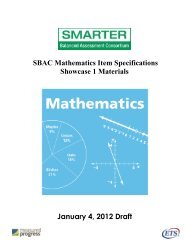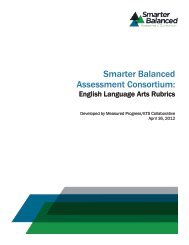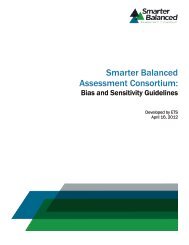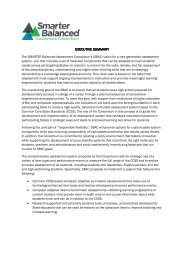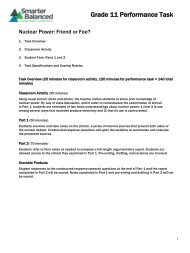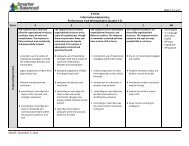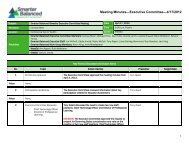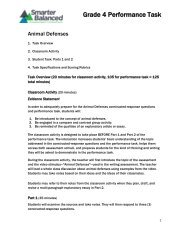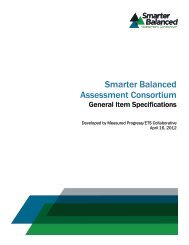Content Specifications for the Summative Assessment of the ...
Content Specifications for the Summative Assessment of the ...
Content Specifications for the Summative Assessment of the ...
Create successful ePaper yourself
Turn your PDF publications into a flip-book with our unique Google optimized e-Paper software.
oxes can be optional drop-down boxes, accessed only if a student needs <strong>the</strong>m. Hint boxes are<br />
only used if <strong>the</strong>y do not change constructs assessed.<br />
Reduce language load/simplify language in <strong>the</strong> question stems and/or <strong>the</strong> response options.<br />
Substitute more familiar words in question stems and response options if that is not <strong>the</strong><br />
vocabulary /construct being assessed. Additionally, innovative (electronic) items might include<br />
hover boxes over certain vocabulary/terms so that students can click to find definitions or brief<br />
explanations <strong>of</strong> terms.<br />
Provide consistent icons and phrasing <strong>of</strong> question stems throughout <strong>the</strong> test.<br />
Use bulleted lists and increased white space in place <strong>of</strong> longer dense texts.<br />
Color-coding to help students to organize in<strong>for</strong>mation.<br />
Provide sub-questions to break up multi-step tasks.<br />
Place inferential and analysis questions after literal questions have been asked.<br />
Provide graphic organizers to help students organize in<strong>for</strong>mation be<strong>for</strong>e answering more<br />
complex questions.<br />
O<strong>the</strong>r item enhancements to be explored may include (but need not be limited to):<br />
Reduce <strong>the</strong> number <strong>of</strong> response options (number <strong>of</strong> distractors) in SR and some technologyenhanced<br />
(TE) items.<br />
Provide e-highlighter option so students can mark <strong>the</strong> passage while reading.<br />
Developing a range <strong>of</strong> items <strong>for</strong> <strong>the</strong> CAT item bank and per<strong>for</strong>mance tasks<br />
Test developers will apply an approach to item and task development with two key ideas in mind – (1)<br />
how to make test items accessible to all learners and (2) how to design items <strong>for</strong> <strong>the</strong> same constructs that<br />
engage novice-to-expert per<strong>for</strong>mers.<br />
In 2006, ACT, Inc., released a report called Reading Between <strong>the</strong> Lines showing that what chiefly<br />
distinguished <strong>the</strong> per<strong>for</strong>mance <strong>of</strong> those students who had earned <strong>the</strong> benchmark score or better from<br />
those who had not was not <strong>the</strong>ir relative ability to make inferences while reading or to answer questions<br />
related to particular cognitive processes, such as determining main ideas or determining <strong>the</strong> meaning <strong>of</strong><br />
words and phrases in context. Instead, <strong>the</strong> clearest differentiator was what students could read, in terms<br />
<strong>of</strong> its complexity. These findings held <strong>for</strong> male and female students, students from all racial/ethnic<br />
groups, and students from families with widely varying incomes. The results <strong>of</strong> <strong>the</strong> ACT study have<br />
been borne out in years <strong>of</strong> results on o<strong>the</strong>r state assessments.<br />
There<strong>for</strong>e, a key aspect <strong>of</strong> <strong>the</strong> continuum <strong>of</strong> difficulty represented on <strong>the</strong> SBAC adaptive test will be<br />
based on <strong>the</strong> complexity <strong>of</strong> <strong>the</strong> texts students are able to comprehend. For example, students could be<br />
provided with short chunks <strong>of</strong> texts from least-to-more complex to build a pr<strong>of</strong>ile <strong>of</strong> <strong>the</strong> students’<br />
expertise. Then, <strong>the</strong> assessment will adapt to <strong>the</strong> level <strong>of</strong> text complexity that students show <strong>the</strong>y can<br />
handle. In addition, item scaffolding and enhancements, detailed above, can be used to support<br />
struggling learners at all grade levels.<br />
44



